Turku
Turku (/ˈtʊərkuː/ TOOR-koo;[13][14] Finnish: [ˈturku] (![]() listen); Swedish: Åbo, Finland Swedish: [ˈoːbu] (
listen); Swedish: Åbo, Finland Swedish: [ˈoːbu] (![]() listen)) is a city and former capital on the southwest coast of Finland at the mouth of the Aura River,[15][16] in the region of Finland Proper (Varsinais-Suomi) and the former Turku and Pori Province (Turun ja Porin lääni; 1634–1997). The region was originally called Suomi (Finland), which later became the name for the whole country. As of 31 March 2021, the population of Turku was 194,244[17] making it the sixth largest city in Finland after Helsinki, Espoo, Tampere, Vantaa and Oulu.[7] There were 281,108[18] inhabitants living in the Turku Central Locality, ranking it as the third largest urban area in Finland after the Capital Region area and Tampere Central Locality. The city is officially bilingual as 5.2 percent of its population identify Swedish as a mother-tongue.[10]
listen)) is a city and former capital on the southwest coast of Finland at the mouth of the Aura River,[15][16] in the region of Finland Proper (Varsinais-Suomi) and the former Turku and Pori Province (Turun ja Porin lääni; 1634–1997). The region was originally called Suomi (Finland), which later became the name for the whole country. As of 31 March 2021, the population of Turku was 194,244[17] making it the sixth largest city in Finland after Helsinki, Espoo, Tampere, Vantaa and Oulu.[7] There were 281,108[18] inhabitants living in the Turku Central Locality, ranking it as the third largest urban area in Finland after the Capital Region area and Tampere Central Locality. The city is officially bilingual as 5.2 percent of its population identify Swedish as a mother-tongue.[10]
Turku
Turku – Åbo | |
|---|---|
City | |
| Turun kaupunki Åbo stad City of Turku | |
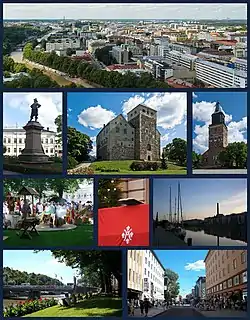 Top row: Aerial view of Turku from atop Turku Cathedral 2nd row: Statue of Per Brahe, Turku Castle, Turku Cathedral 3rd row: Turku Medieval Market, The Christmas Peace Balcony of Turku, Twilight on the Aura River Bottom row: Summer along the Aura River, view of Yliopistonkatu pedestrian area | |
 Flag Coat of arms | |
| Nickname(s): | |
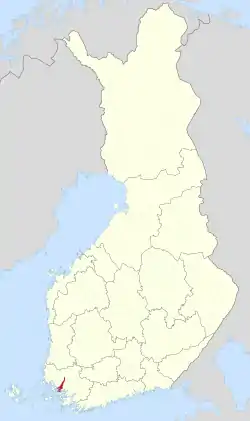 | |
| Coordinates: 60°27′N 022°16′E | |
| Country | |
| Region | Southwest Finland |
| Sub-region | Turku sub-region |
| First historical record | 1229[3] |
| First possible appearance on map | 1154[3] |
| Capital city | 17 September 1809 – 8 April 1812[4][5] |
| Government | |
| • Mayor | Minna Arve |
| Area (2018-01-01)[6] | |
| • City | 306.36 km2 (118.29 sq mi) |
| • Land | 245.67 km2 (94.85 sq mi) |
| • Water | 60.7 km2 (23.4 sq mi) |
| • Urban | 252.65 km2 (97.55 sq mi) |
| • Metro | 2,331.1 km2 (900.0 sq mi) |
| • Rank | 247th largest in Finland |
| Population (2021-12-31)[7] | |
| • City | 195,301 |
| • Rank | 6th largest in Finland |
| • Density | 794.97/km2 (2,059.0/sq mi) |
| • Urban | 252,468[8] |
| • Urban density | 9,993/km2 (25,880/sq mi) |
| • Metro | 330,192[9] |
| Population by native language | |
| • Finnish | 88.1% (official) |
| • Swedish | 5.2% (official) |
| • Others | 6.7% |
| Population by age | |
| • 0 to 14 | 12.6% |
| • 15 to 64 | 66.5% |
| • 65 or older | 20.9% |
| Time zone | UTC+02:00 (EET) |
| • Summer (DST) | UTC+03:00 (EEST) |
| Postal code | 20000–20960 |
| Municipal tax rate[12] | 19.5% |
| Website | www.turku.fi |
It is unknown when Turku gained city rights. The Pope Gregory IX first mentioned the town Aboa in his Bulla in 1229 and the year is now used as the foundation year of Turku.[3] Turku is the oldest city in Finland, and served as the most important city of the eastern part of the Kingdom of Sweden (modern-day Finland). After the Finnish war, Finland became an autonomous grand duchy of the Russian Empire in 1809, and Turku was made the capital of the grand duchy. However, Turku lost its status as capital only after three years in 1812, when Tsar Alexander I of Russia decided to move the capital to Helsinki. It was only after the last great fire in 1827 that most governmental institutions were moved to Helsinki along with the Royal Academy of Turku (Turun Akatemia) founded in 1640, which then became the University of Helsinki, thus consolidating Helsinki's position as the new capital. Turku continued to be the most populous city in Finland until the end of the 1840s, and it remains the regional capital and an important business and cultural center and port.
Because of its long history, it has been the site of many important events, and has extensively influenced Finnish history as the former capital city. Along with Tallinn, the capital city of Estonia, Turku was designated the European Capital of Culture for 2011. In 1996, it was declared the "Christmas City" of Finland.[19] Also, Turku has been officially declared the Food Capital of Finland,[20][21] because it holds a number of Finland's oldest, highest quality restaurants alongside a historically famous fish market, held twice a year.[22] Turku's canteen and café culture has often been compared to French food culture, which is why Turku has also been perceived as "Paris of Finland";[1][2] this is also the reason for the Swedish saying: "Varför Paris, vi har ju Åbo!" ("Why Paris, we have Turku!")[1]
Due to its location, Turku is a notable commercial and passenger seaport with over three million passengers traveling through the Port of Turku each year to Stockholm and Mariehamn.[15]
Names and etymology
The Finnish name Turku originates from an Old East Slavic word, tǔrgǔ, meaning "market place".[23] The word turku still means "market place" in some Finnish dialects.
The Swedish name Åbo may be a simple combination of å ("river; creek; large stream") and bo ("dwelling"). There is however an old legal term called "åborätt" (meaning roughly "right to live at"), which gave citizens (called "åbo") the inheritable right to live at land owned by the crown (å meant at or on in old Swedish, now på).[24]
In Finnish, the genitive of Turku is Turun, meaning "of Turku". The Finnish names of organizations and institutes of Turku often begin with this word, as in Turun yliopisto for the University of Turku.
History
Turku has a long history as Finland's largest city and occasionally as the administrative center of the country, but for the last two hundred years has been surpassed by Helsinki. The city's identity stems from its status as the oldest city in Finland[25] and the country's first capital. Originally, the word "Finland" referred only to the area around Turku (hence the title, "Finland Proper" for the region).

Archaeological findings in the area date back to the Stone Age and the area was densely populated in the Iron Age. The oldest known road, Hämeen härkätie, connected to region and the Old Castle of Lieto to Tavastia in the 9th Century at the latest.[26] Early literary sources such as Al-Idrisi's world map from 1154 mentions Turku.[3] Turku Cathedral was consecrated in 1300.[27]
During the Middle Ages, Turku was the seat of the Bishop of Turku (a title later upgraded to Archbishop of Turku), covering then the eastern half of the Kingdom of Sweden (most of the present-day Finland) until the 17th century. Even if Turku had no official capital status, both the short-lived institutions of Dukes and Governors-General of Finland usually had their Finnish residences there. In the aftermath of the War against Sigismund, the town was the site of the Åbo Bloodbath. In 1640, the first university in Finland, the Royal Academy of Turku, was founded in Turku. Turku was also the meeting place for the States of Finland in 1676.
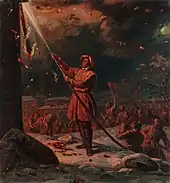
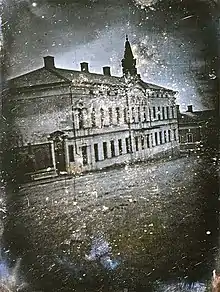
After the Finnish War, which ended when Sweden ceded Finland to Imperial Russia at the Treaty of Fredrikshamn in 1809, Turku became briefly the official capital, but soon lost the status to Helsinki, as Emperor Alexander I felt that Turku was too far from Russia and too aligned with Sweden to serve as the capital of the Grand Duchy of Finland. The change officially took place in 1812. The government offices that remained in Turku were finally moved to the new capital after the Great Fire of Turku, which destroyed a large portion of the city in 1827.[28] After the fire, a new and safer city plan was drawn up by German architect Carl Ludvig Engel, who had also designed the new capital, Helsinki.[29] Turku remained the largest city in Finland for another twenty years.
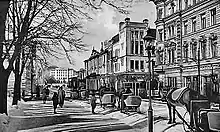
In 1918, a new university, the Åbo Akademi – the only Swedish-language university in Finland – was founded in Turku.[30] Two years later, the Finnish-language University of Turku was founded alongside it. These two universities are the second and third to be founded in Finland, both by private donations.
In the 20th century, Turku was called "Finland's gateway to the West" by historians such as Jarmo Virmavirta.[31] The city enjoyed good connections with other Western European countries and cities, especially since the 1940s with Stockholm across the Gulf of Bothnia. In the 1960s, Turku became the first Western city to sign a twinning agreement with Leningrad in the Soviet Union, leading to greater inter-cultural exchange and providing a new meaning to the city's 'gateway' function. After the fall of communism in Russia, many prominent Soviets came to Turku to study Western business practices, among them Vladimir Putin, then Leningrad's deputy mayor.[32]
As for architecture in the city, both the body of architectural styles as well as the prevalent way of living have experienced significant changes in the 20th century. While having survived relatively intact throughout the years of war 1939–1945, the city faced increasing changes in the 1950s and 1960s due to rising demands for apartments, the eagerness to rebuild, and most of all the new development of infrastructure (especially increased automobile traffic). The wooden one- to two-story houses that were the dominant mode of building in the city were mostly demolished in the 1950s and 1960s to both enable more efficient building and to ease vehicle traffic. This resulted in the destruction of buildings that were, in later decades, seen as beautiful and worth saving. Some individual buildings remain controversial to this day when it comes to their demolition in the decades after the war. For example, the building of Hotel Phoenix that stood on corner of the Market Square was torn down to make way for a large, multistory apartment building in 1959. The building was significant both for its location and history: having stood on one of the most valuable lots in the city center since 1878, the building had, for example, served as the first main building of the University of Turku. Other buildings whose demolition was seen as scandalous, either already at the time of action or proved to be so in later years, include The Nobel House (subject of the very first photograph ever taken in Finland) and the building of Old Hotel Börs which was built in jugendstil in 1909 by Frithiof Strandell.
Geography
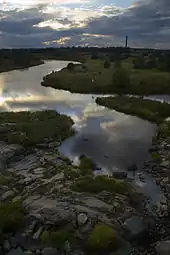
Located at the mouth of the Aura river in the southwestern corner of Finland, Turku covers an area of 245 square kilometres (95 sq mi) of land, spread over both banks of the river. The eastern side, where the Turku Cathedral is located, is popularly referred to as täl pual jokke ("this side of the river"), while the western side is referred to as tois pual jokke ("the other side of the river"). The city center is located close to the river mouth, on both sides of the river, though development has recently been expanding westward.
There are ten bridges over the Aura river in Turku. The oldest of the current bridges is Auransilta, which was constructed in 1904. The newest bridge is Kirjastosilta ('library bridge'), a pedestrian-only bridge built in 2013.[33] The Föri, a small ferry that transports pedestrians and bicycles across the river without payment, is a well known feature of the city.
With a population of approximately 200,000,[34] the Turku Region (LAU 1) is the third largest urban region in Finland, after Greater Helsinki and the area around Tampere. The region includes, in addition to the city itself the following municipalities: Askainen, Kaarina, Lemu, Lieto, Masku, Merimasku, Mynämäki, Naantali, Nousiainen, Paimio, Piikkiö, Raisio, Rusko, Rymättylä, Sauvo, Vahto, and Velkua.
A more exclusive definition for the urban area is the city region of Turku with a population around 235,000 consisting of four major municipalities Kaarina, Raisio, Naantali, and Turku.
Administrative subdivisions
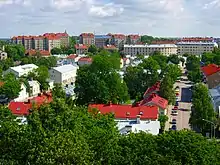
The city is divided into 78 districts and nine wards that do not function as local government units. There are, however, some projects that are based on the district divisions, particularly in the eastern part of the city, where unemployment is high in certain areas. The largest populated districts are Varissuo and Runosmäki. By area, however, Kakskerta and Paattinen, formed from former municipalities that were annexed to the city proper in the mid-20th century, constitute the largest districts.
As many of the small neighbouring municipalities from the north and south of the city were annexed during the mid-20th century, Turku is today shaped like an elongated pear. The city centre and most of the suburban areas lie in the middle, separated from the less densely populated northern rural areas by the Turku bypass, that forms part of European route E18. Islands such as Ruissalo, Hirvensalo and Kakskerta, forming the southern part of the city, are also sparsely populated and mostly contain summer residences, with the exception of some districts in Hirvensalo which are currently growing into upper-middle-class suburbs.
Climate
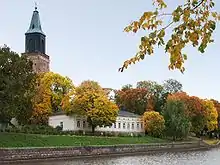
Situated by the Baltic Sea and sheltered by the islands of the Archipelago Sea, Turku has a humid continental climate (Köppen Dfb). Like much of southern Finland, the city experiences warm summers, with temperatures ranging up to 30 °C (86 °F), and relatively cold winters with frequent snowfall. The warmest month of the year is July, with an average temperature of 17.5 °C (64 °F), whereas the coldest month is February. The average year-round temperature is 5.5 °C (42 °F). Winter usually starts in early December, and spring in late March.
Precipitation in Turku averages 720 mm (28.3 in) a year. The rainiest month of the year is August, when the city receives on average 80 mm (3.1 in) of rainfall. In April, the driest month of the year, the figure is only 32 mm (1.3 in). The average air pressure at sea level is 101.2 kilopascals (29.9 inHg), with little variance throughout the year.
Operational since 1955, the city's weather station is located at an altitude of 47 metres (154 feet) at Turku Airport.[35] The weather in the city itself is affected by the proximity of the sea, so the wintertime temperatures are often milder than those measured at the airport. The moderating impact of the sea helps oak maple and ash trees, which are quite rare elsewhere in Finland, to thrive by the areas along the shoreline and in the archipelago. [36]
| Climate data for Turku Airport (elevation 47 m) 1991-2020 normals, extremes 1900- present | |||||||||||||
|---|---|---|---|---|---|---|---|---|---|---|---|---|---|
| Month | Jan | Feb | Mar | Apr | May | Jun | Jul | Aug | Sep | Oct | Nov | Dec | Year |
| Record high °C (°F) | 8.5 (47.3) |
10.2 (50.4) |
15.8 (60.4) |
24.5 (76.1) |
30.0 (86.0) |
32.0 (89.6) |
35.9 (96.6) |
32.6 (90.7) |
27.8 (82.0) |
18.9 (66.0) |
14.0 (57.2) |
11.0 (51.8) |
35.9 (96.6) |
| Average high °C (°F) | −1.1 (30.0) |
−1.2 (29.8) |
2.6 (36.7) |
9.1 (48.4) |
15.5 (59.9) |
19.5 (67.1) |
22.6 (72.7) |
21.1 (70.0) |
15.7 (60.3) |
8.8 (47.8) |
3.6 (38.5) |
0.7 (33.3) |
9.7 (49.5) |
| Daily mean °C (°F) | −3.8 (25.2) |
−4.5 (23.9) |
−1.3 (29.7) |
4.1 (39.4) |
10.0 (50.0) |
14.4 (57.9) |
17.5 (63.5) |
16.2 (61.2) |
11.3 (52.3) |
5.7 (42.3) |
1.5 (34.7) |
−1.5 (29.3) |
5.8 (42.5) |
| Average low °C (°F) | −6.5 (20.3) |
−7.1 (19.2) |
−4.7 (23.5) |
−0.2 (31.6) |
4.6 (40.3) |
9.3 (48.7) |
12.5 (54.5) |
11.6 (52.9) |
7.4 (45.3) |
2.8 (37.0) |
−0.9 (30.4) |
−4.1 (24.6) |
2.1 (35.8) |
| Record low °C (°F) | −35.5 (−31.9) |
−35.2 (−31.4) |
−32.8 (−27.0) |
−21.0 (−5.8) |
−6.6 (20.1) |
−2.2 (28.0) |
1.8 (35.2) |
0.2 (32.4) |
−6.9 (19.6) |
−15.0 (5.0) |
−22.3 (−8.1) |
−33.8 (−28.8) |
−35.5 (−31.9) |
| Average precipitation mm (inches) | 58 (2.3) |
42 (1.7) |
39 (1.5) |
32 (1.3) |
35 (1.4) |
55 (2.2) |
74 (2.9) |
73 (2.9) |
59 (2.3) |
73 (2.9) |
71 (2.8) |
73 (2.9) |
684 (27.1) |
| Average precipitation days | 11 | 9 | 8 | 7 | 7 | 8 | 8 | 10 | 9 | 11 | 13 | 12 | 113 |
| Mean monthly sunshine hours | 40 | 75 | 134 | 204 | 284 | 276 | 287 | 230 | 155 | 89 | 38 | 27 | 1,839 |
| Source: Climatological statistics for the normal period 1991–2020[37] | |||||||||||||
Demographics
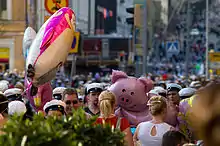
At the end of 2021, the Turku region (including the economic districts of Turku and Åboland) had a population of 337,588, out of which 195,137 people lived in the city of Turku. This makes the Turku region Finland's third largest, after Helsinki and Tampere, being home to 6% of Finland's population. The city's population density is 794.4 inhabitants per square kilometre. The median age in the city is 42.1, lower than the national average of 43.6.
| Population by mother tongue[38] | ||
| Language | Population (2021) | Percentage |
|---|---|---|
| Finnish | 159,283 | 81.6% |
| Swedish | 10,710 | 5.5% |
| Russian | 3,252 | 1.7% |
| Arabic | 3,060 | 1.6% |
| Kurdish | 2,125 | 1.1% |
| Albanian | 1,848 | 0.9% |
| Somali | 1,622 | 0.8% |
| Estonian | 1,535 | 0.8% |
| Persian | 1,070 | 0.5% |
| English | 1,050 | 0.5% |
| Vietnamese | 742 | 0.4% |
| Romanian | 671 | 0.3% |
| Chinese | 573 | 0.3% |
| Serbo-Croatian | 553 | 0.3% |
| Polish | 534 | 0.3% |
| Spanish | 533 | 0.3% |
13.2% of Turku's population has a foreign-background. The largest groups are from Russia, Iraq and former Yugoslavia.
| Largest groups of foreign residents[39] | ||
| Nationality | Population (2021) | % |
|---|---|---|
| 3,455 | 1.8 | |
| 2,984 | 1.5 | |
| 2,228 | 1.1 | |
| 1,797 | 0.9 | |
| 1,617 | 0.8 | |
| 1,582 | 0.8 | |
| 1,239 | 0.6 | |
| 781 | 0.4 | |
| 664 | 0.3 | |
| 616 | 0.3 | |
| 553 | 0.3 | |
| 527 | 0.3 | |
| 521 | 0.3 | |
Economy
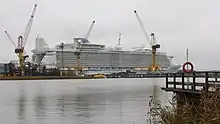
The business district in the city's economy is centred on the Port of Turku and other service-oriented industries. The city is also a renowned high tech centre – the Turku Science Park area in Kupittaa hosts over 300 companies from the fields of biotechnology and information technology, as well as several institutions of higher learning that work closely with the business sector. This cooperative element is seen as a particularly important factor with regards to the city's expected future economic development, as outlined in the Turku Strategy that is published annually by the city council. At least the following major Finnish companies have their corporate headquarters in Turku: HKScan and Hesburger. Other major companies which have operations in Turku include Bayer, Fläkt Woods, Meyer Werft, Orion Corporation and Wärtsilä.
As of June 2015, over 280,000 people were registered as being without employment in Finland. This put June's numbers at 10.0 percent of the population, 0.8 percentage points higher than June 2014. Men's unemployment rate was 10.5 percent and women's 9.4 percent.[40]
Culture
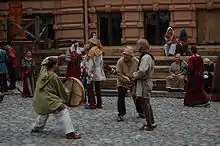
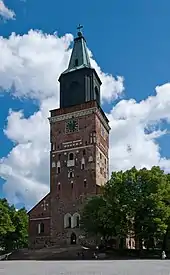
Cultural venues in Turku include several theatres, cinemas, and art galleries, and a city philharmonic orchestra. The city's cultural centre organises a number of regular events, most notably the Medieval Market in July each year. Turku is also the official Christmas city of Finland, and 'Christmas Peace' in Finland is declared on every 24 December from the Brinkkala Hall balcony. The Turku music festival and the rock festival Ruisrock (held on the island of Ruissalo) are among the oldest of its kind in the Nordic countries. The city also hosts another rock festival, Down by the Laituri, and one of the largest electronic music festivals in Northern Europe, UMF[41] (Uuden Musiikin Festivaali, "New Music Festival"), in addition to a vibrant nightlife, centred on the Market Square.
There are also numerous museums, such as the Turku Art Museum and the Wäinö Aaltonen Museum of Art. The Åbo Akademi University maintains the Sibelius Museum, which is the only museum in Finland specialising in the field of music. Apart from these, there are also several historical museums that display the city's medieval period, such as the Turku Castle, which has been a functional historical museum since 1881, and the Aboa Vetus museum, built in the late 1990s over the 14th century archaeological site; countless excavations have been carried out in the city each year in order to gain more clarity on the city's birth history.[42][43][44] The Luostarinmäki handicrafts museum, converted from residential buildings that survived the Great Fire of Turku in 1827, was the first Scandinavian venue to receive the "Golden Apple" tourism award.
Considered to be the most important religious building in Finland, the Turku Cathedral has borne witness to many important events in the nation's history and has become one of the city's most recognizable symbols with the Turku Castle. The cathedral is situated in the heart of Turku next to the Old Great Square, by the Aura River. Its presence extends beyond the local precinct by having the sound of its bells chiming at noon broadcast on national radio. It is also central to Finland's annual Christmas celebrations. It is also known as resting place for many remarkable bishops and captains of war as well as one Queen of Sweden, Catherine Månsdotter.[45]
Turku was the European Capital of Culture in 2011,[46] and the city council has approved numerous projects to boost the city's image in preparation for that status.
The Declaration of Christmas Peace has been a tradition in Finland from the Middle Ages every year, except in 1939 due to the Winter War. The declaration takes place on the Old Great Square of Turku, Finland's official 'Christmas City', at noon on Christmas Eve. The declaration ceremony begins with the hymn Jumala ompi linnamme (Martin Luther's Ein feste Burg ist unser Gott) and continues with the Declaration of Christmas Peace read from a parchment roll in Finnish and Swedish.
City rivalry with Tampere
Turku ostensibly has a long-standing mutual feud with the city of Tampere,[47] the capital of Pirkanmaa and the third largest city of Finland, and they tend to compete for the title of being the "second grand city of Finland" after Helsinki.[48][49] This hostility is largely expressed in jokes in one city about the other; prominent targets are the traditional Tampere food, mustamakkara, the state of the Aura River in Turku, and the regional accents. Like Turku, Tampere is well known as a food destination because of its food culture. Since 1997, students at Tampere have made annual excursions to Turku to jump on the market square, doing their part to undo the post-glacial rebound and push the city back into the Baltic Sea.[50][51]
Sports

The city has two football teams playing at the top national level, the Veikkausliiga: FC Inter and TPS. TPS is one of the oldest football clubs in Finland. Both teams play their home matches at Veritas Stadion in the district of Kupittaa.
HC TPS of Turku is one of the most successful teams in Finnish ice hockey history. It plays in the Finnish top league, SM-liiga. HC TPS has won the national championship 11 times, the latest being from season 2009–2010. Gatorade Center, formerly named HK Arena, located in the Artukainen district, is used as the venue for HC TPS games.
The Paavo Nurmi Marathon is an annual sporting event in Turku, named after the world-famous runner Paavo Nurmi, who was born and raised in the city.
Finland's most successful tennis player, Jarkko Nieminen, was born and lives in the neighbouring county of Masku
Turku is also home to the Eagles Rugby Football Club (turkurugby.fi) who are part of the championship division of Suomen Rugbyliitto (SRL). They play games and train at Impivaara Jalkapallonhalli and Kuppitaanpuisto.
Turku Titans is a lacrosse club based in Turku with a relevantly successful history with three silver medals and one gold medal in the national lacrosse league in Finland. The Titans women's team has also had a successful history.[52] The FIL U19 2012 World Lacrosse Championships were also held in the city.[53]
Government and politics
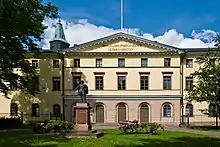
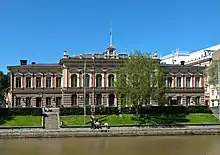
Being both a regional and provincial capital, Turku is an important administrative centre, hosting the seat of the Archbishop of Finland and a Court of Appeal. Minna Arve has been the mayor of Turku since 2017.[54] Since August 2021 her role as the mayor has been an elected office instead of a hired position.[55][56]
The city council of Turku has 67 seats. Following the 2021 municipal election, the council seats are allocated in the following way: National Coalition Party 16 seats, Social Democrats 13, Left Alliance 11, Green League 10, True Finns 9, Centre Party 3, Swedish People's Party 3, Movement Now 1, and Christian Democrats 1.[57] The current chair of the city board is Sini Ruohonen from National Coalition Party.
Results of the 2019 Finnish parliamentary election in Turku:
- National Coalition Party 20.5%
- Social Democratic Party 17.1%
- Left Alliance 16.8%
- True Finns 15.7%
- Green League 13.8%
- Swedish People's Party 5.5%
- Centre Party 4.7%
- Movement Now 1.9%
- Christian Democrats 1.6%
Transport
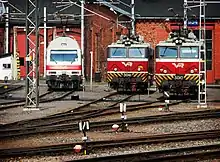
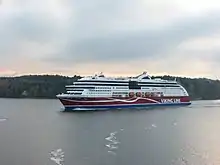
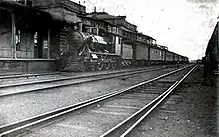
For a city of its size, Turku has a moderate public transport network of bus routes, which is comparable to the bus network of similar-sized Tampere. The bus network is managed and supervised by the Turku City Region's Public Transport Committee (FÖLI) (Finnish: Turun kaupunkiseudun joukkoliikennelautakunta, Swedish: kollektivtrafiknämnden för Åbo stadsregion), and is operated mainly by private companies. Bus traffic to and in the neighbouring municipalities of Kaarina, Lieto, Naantali, Raisio and Rusko are also handled by FÖLI. The bus rates are the same when traveling within these municipalities.[58]
Rail traffic to and from Turku is handled by the Finnish national carrier, VR. The number of services has fallen and only the railways towards Tampere and Helsinki are now in use. The railway stations currently used for passenger traffic are the Turku Central railway station in Pohjola, and two smaller stations in Kupittaa and the Port of Turku.
There is no local rail traffic at the moment, as the city's popular tram services were discontinued in 1972, and the various local railway lines to neighbouring towns and municipalities were all abolished during the late 20th century. However, there are plans for a light rail system in the Turku region in the near future. This system would more ably serve major suburbs of the city such as Varissuo and Runosmäki, as well as the neighbouring cities.[59]
The State of Finland has announced plans to support Espoo with 30% of full expenses on a new metro rail, the Regional Council of Southwest Finland is going to use this as a test case for a new light rail network in Turku.[60]
The Turku Bus Station and the Turku Central railway station are currently located in different places. The City of Turku is planning to combine these two in a new greater station complex in the near future. This new travel center will consist of a hotel and several shopping estates. This center will connect all public transportation from commuter trains to long-distance buses.
Turku's most significant highways for traffic are Highway 1 leading to Helsinki; Highway 10 leading to Hämeenlinna; Highway 9 leading to Tampere, Jyväskylä, Kuopio and Joensuu; Highway 8 leading to Pori, Vaasa and Oulu; and the Turku Ring Road, which protrudes circumferentially from Turku.
Turku Airport is located 8 kilometres (5 miles) to the north of the city centre, partly in the neighbouring municipality of Rusko. The airport is served by six passenger airlines, including airBaltic and SAS Scandinavian, and one cargo airline.
There are also daily ferry services from the Port of Turku to Sweden and Åland, operated by Silja Line and Viking Line. These are something of a Finnish cultural tradition (see ruotsinlaiva), and people often travel long distances across Finland to Turku just to take a cruise across the Gulf of Bothnia.
The Archipelago Sea boat traffic is handled by, among others, SS Ukkopekka, an old steamship that cruises on the route Turku-Naantali-Turku.
Turku is the only city in Finland to have three long-distance railway stations: Turku Central, Port of Turku, and Kupittaa.
Education
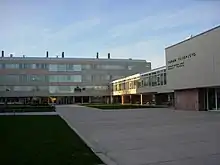
Turku has a longer educational history than any other Finnish city – the first school in the city, the Cathedral School, was founded along with Turku Cathedral in the late 13th century. The first university in Finland, the Royal Academy of Turku (now University of Helsinki), was established in the city in 1640. In 1820, the first school in Finland conforming to the Bell-Lancaster method was founded in Turku with the aim of making primary education more inclusive to the lower classes.
Turku is home to about 35,000 higher education students.[61] There are two universities and several "polytechnics" in the town.
The Finnish University of Turku is the second largest university in Finland (18,000 students), as measured by student enrollment, and one of the oldest as well, having been founded in 1920. Åbo Akademi, founded 1918 as the second university of Finland, is one of Finland's two Swedish-language universities. Turku School of Economics merged with The University of Turku in 2010, and Åbo handelshögskola, its Swedish counterpart, with Åbo Akademi 1980. The central hospital of Turku, Turku University Hospital, is affiliated with the University and it is used as a teaching hospital.
Turku University of Applied Sciences is the second largest polytechnic in Finland after Metropolia University of Applied Sciences. Also Novia University of Applied Sciences and Diaconia University of Applied Sciences have campuses in the town.
Turku is one of only two cities in Finland to have an established international school (the other city being Helsinki). Turku International School, located in the eastern district of Varissuo, has been operating since 2003. By an agreement signed between the city of Turku and the University of Turku, Turun normaalikoulu takes care of the teaching in the international school.[62]
Media

The most widely read newspaper of Turku, and the area around it, is the daily regional morning newspaper Turun Sanomat, with a readership of over 70% of the population every day. Åbo Underrättelser, a Swedish language newspaper published in Turku, is the oldest newspaper in Finland, having been published since 1824. The free-of-charge Turkulainen newspaper is also among the most popular newspapers, together with the local edition of Metro International and the national evening tabloid Ilta-Sanomat.[63] There are also a number of local newspapers such as Kulmakunta (for the eastern suburbs of Turku, including Varissuo and Lauste), and Rannikkoseutu (for the area around the neighbouring cities of Raisio and Naantali).
The first Finnish newspaper Tidningar Utgifne Af et Sällskap i Åbo, in Swedish, was started in Turku in 1771,[64] as well as the first Finnish-language newspaper Suomenkieliset Tieto-Sanomat which was started in 1775.
The newspaper Turun Sanomat also operates a regional television station, called Turku TV. The Finnish national broadcaster Yleisradio screens local news, daily from Monday to Friday, for the Southwest Finland (including the regions of Southwest Finland and Satakunta) residents. All Finnish national TV channels are viewable and national radio channels audible in the Turku area. In addition, a number of local radio stations, e.g. Auran Aallot, Radio Sata and Radio Robin Hood are operational. Local public service radio stations are Yle Turun Radio in Finnish language (the regional version of Yle Radio Suomi) and Yle Vega Åboland in Swedish language (the regional version of Yle Vega).
Notable people
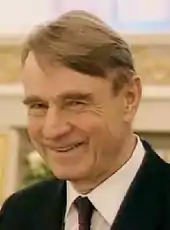
- Agnes Lundell (1878 –1936), Finland's first female lawyer.
- Rauno Aaltonen, rally driver
- Teemu Brunila, singer, songwriter, musician and producer
- Antti Buri, racing driver
- Darude, dance musician, artist of the hit song Sandstorm
- Alex Federley, political cartoonist and illustrator
- Marcus Forss, football player, member of Finland's UEFA Euro 2020 squad
- Johan Gadolin, chemist, physicist and mineralogist
- Utti Hietala, bodybuilder
- Vera Hjelt, Member of Parliament and social reformer
- Lukáš Hrádecký, football goalkeeper, member of Finland's UEFA Euro 2020 squad
- Kaapo Kakko, hockey player
- Katja Kallio (born 1968), novelist, journalist, columnist and screenwriter
- Joni Kauko, football player, member of Finland's UEFA Euro 2020 squad
- Miikka Kiprusoff, former professional ice hockey goaltender who played for the Calgary Flames and San Jose Sharks during his NHL career
- Mauno Koivisto, 9th President of Finland
- Saku and Mikko Koivu, ice hockey playing brothers playing respectively in Montréal and Anaheim Ducks and Minnesota Wild as an alternate captain and captain
- Christina Krook (1742–1806), educator
- Joalin Loukamaa, a member of global pop group Now United
- Erik Johan Löfgren, portrait painter
- Baron C. G. E. Mannerheim, military leader and statesman
- Niklas Moisander, former captain of Finnish national football team
- Michael Monroe, rock musician, the vocalist of Hanoi Rocks
- Paavo Nurmi, The Flying Finn, 9 time Olympic Champion in long-distance running
- Joni Ortio, professional ice hockey goaltender currently playing for HC Vityaz of the KHL
- Elli Pikkujämsä, defender for KIF Örebro DFF and the Finland women's national football team
- Rasmus Ristolainen, hockey player currently with the Philadelphia Flyers of the NHL
- Seppo Ruohonen (1946-2020), opera singer
- Jiri "Linkzr" Masalin, Professional Overwatch player for the team Houston Outlaws and two time player for Finland in the Overwatch World Cup
- Joona "Fragi" Laine, Former professional Overwatch player for the Philadelphia Fusion, and briefly for the Guangzhou Charge
- Aleksi "Zuppeh" Kunti, former professional Overwatch player for the Florida Mayhem and team Gigantti
- Joonas "Zappis" Alakurti, retired professional Overwatch player for the Florida Mayhem and team Gigantti
- Jarno Saarinen, 1972 Grand Prix motorcycle racing world champion
- Matti Salminen, bass singer
- Henri Sigfridsson, classical pianist
- Tabe Slioor, socialite, reporter and photojournalist
- Herman Spöring Jr., explorer and botanist
- Niilo Sevänen, vocalist and bass guitarist of Insomnium
- Elsa Sylvestersson, ballet dancer and choreographer
- Jere Uronen, football player, member of Finland's UEFA Euro 2020 squad
- Jonne Valtonen, composer
- Tony Vidgren, ice hockey player
- Johannes Rojola, developer of My Summer Car
International relations
Twin towns – sister cities
 Aarhus, Denmark (1946)
Aarhus, Denmark (1946) Bergen, Norway (1946)
Bergen, Norway (1946) Bratislava, Slovakia (1976)
Bratislava, Slovakia (1976) Cologne, Germany (1967)
Cologne, Germany (1967) Constanța, Romania (1958)
Constanța, Romania (1958) Florence, Italy (1992)
Florence, Italy (1992) Gdańsk, Poland (1958)
Gdańsk, Poland (1958) Gothenburg, Sweden (1946)
Gothenburg, Sweden (1946) Kharkiv, Ukraine (2022)
Kharkiv, Ukraine (2022) Rostock, Germany (1958)
Rostock, Germany (1958) Szeged, Hungary (1971)
Szeged, Hungary (1971) Tartu, Estonia (2008)
Tartu, Estonia (2008) Varna, Bulgaria (1963)
Varna, Bulgaria (1963)
In March 2022, Turku suspended the agreement with Saint Petersburg, Russia (twinning since 1953[65]) due to the Russian invasion of Ukraine.[66]
Gallery
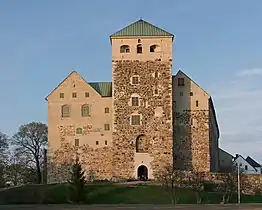 The medieval Turku Castle as seen from the harbour side
The medieval Turku Castle as seen from the harbour side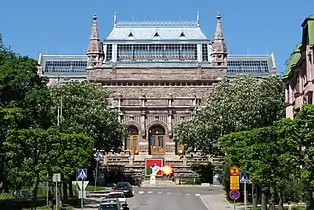 Turku Art Museum is a classical example of Romantic nationalism in architecture.
Turku Art Museum is a classical example of Romantic nationalism in architecture.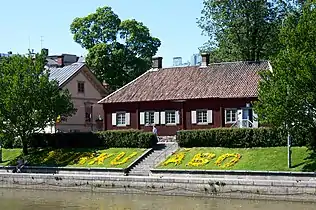 Pharmacy museum
Pharmacy museum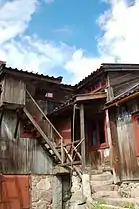 Luostarinmäki open-air museum
Luostarinmäki open-air museum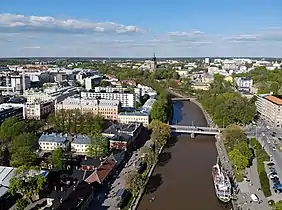 Aura River in central Turku
Aura River in central Turku
See also
- Archipelago Sea
- Bishop Henry
- Christmas Peace
- Great Fire of Turku
- King's Road
- Medieval Market of Turku
- Pori
- Posankka
- Royal Academy of Turku
- The Tomten in Åbo Castle
- Turku Cemetery
- Turku sub-region
Other medieval cities and towns of Finland
- Naantali
- Porvoo
- Rauma
- Ulvila
- Vyborg (now in Russia)
References
Bibliography
- Anttonen, Martti (ed) (1992). Täällä Suomen synnyinmuistot. Jyväskylä: Varsinais-Suomen maakuntaliitto. (in Finnish)
- Knuuti, Heikki et al. (1986). Kotikaupunkini Suomen Turku. Keuruu: Otava Publishing. (in Finnish)
- Virmavirta, Jarmo (2004). Finland's City of Turku. Keuruu: Otava Publishing.
- Turun kaupunki (2007). Muutoksen suunnat 3/2007. Retrieved 27 September 2007.
Notes
- Varför Paris, vi har ju Åbo! – Paulig Archived 12 September 2021 at the Wayback Machine (in Finnish)
- Turun Vierasvenesatama – Kiss My Turku Archived 12 September 2021 at the Wayback Machine (in Finnish)
- Suomen historian merkkipaaluja: Ensimmäisenä Turussa Archived 30 April 2021 at the Wayback Machine (in Finnish)
- "Bicentennial of Helsinki as Finnish capital". Yle News. 8 April 2012. Retrieved 8 April 2022.
- "Lobbying for Helsinki 200 years ago". Helsinki Times. 19 April 2012. Retrieved 8 April 2022.
- "Area of Finnish Municipalities 1.1.2018" (PDF). National Land Survey of Finland. Retrieved 30 January 2018.
- "Preliminary population structure by area, 2021M01*-2021M12*". StatFin (in Finnish). Statistics Finland. Retrieved 2 February 2022.
- "Taajamat väkiluvun ja väestöntiheyden mukaan 31.12.2011". Tiedote (in Finnish). Statistics Finland (Tilastokeskus). 31 December 2011. Archived from the original on 12 April 2013. Retrieved 28 March 2013.
- http://pxnet2.stat.fi/PXWeb/pxweb/fi/StatFin/StatFin__vrm__vamuu/statfin_vamuu_pxt_001.px/table/tableViewLayout2/?rxid=be87bf03-2bee-49e1-8a2f-ad390937d954%5B%5D
- "Population according to language and the number of foreigners and land area km2 by area as of 31 December 2008". Statistics Finland's PX-Web databases. Statistics Finland. Retrieved 29 March 2009.
- "Population according to age (1-year) and sex by area and the regional division of each statistical reference year, 2003–2020". StatFin. Statistics Finland. Retrieved 2 May 2021.
- "List of municipal and parish tax rates in 2021" (PDF). Tax Administration of Finland. 1 December 2020. Retrieved 10 April 2021.
- "Turku" Archived 12 April 2019 at the Wayback Machine (US) and "Turku". Lexico UK English Dictionary. Oxford University Press. Archived from the original on 22 March 2020.
- "Turku". Merriam-Webster Dictionary. Retrieved 12 April 2019.
- "Statistical yearbook of Turku" (in Finnish). 17 July 2008. Archived from the original on 27 September 2007.
- 'Aluetietopankki' at the Kuntaliitto website
- "Preliminary population 2018". 5 November 2018. Archived from the original on 29 October 2014.
- "Turku Central Locality, Preliminary population by Month". 31 December 2020. Retrieved 6 April 2022.
- "Christmas City » Turku, the Finnish Christmas City". www.turku.fi. Archived from the original on 16 July 2011. Retrieved 6 May 2009.
- "Turku, the Food Capital of Finland". thefoodellers.com. Archived from the original on 27 October 2021. Retrieved 27 October 2021.
- "Finland's former capital Turku is now the culinary capital | Baltic Rim Economies". sites.utu.fi. Archived from the original on 13 November 2020. Retrieved 13 November 2020.
- Wood, Jessica (10 February 2018). "11 Places in Finland Perfect for Food Lovers". Culture Trip. Archived from the original on 29 September 2021. Retrieved 27 October 2021.
- "Keskiaika – Suomen kaupungit keskiajalla". Katajala.net. Archived from the original on 3 March 2016. Retrieved 16 September 2011.
- sv:Åborätt
- "Destinations in Finland – Official Travel and Tourism Guide". Visitfinland.com. Archived from the original on 13 November 2008. Retrieved 6 May 2009.
- Masonen, Jaakko (1991). Hämeen Härkätie. Helsinki: Otava. pp. 186–190. ISBN 951-1-11421-2.
- Andrew Spicer (2012). Lutheran Churches in Early Modern Europe. Ashgate Publishing, Ltd. p. 314. ISBN 978-0-7546-6583-0. Archived from the original on 22 May 2016. Retrieved 14 November 2015.
- "Information about Turku". InfoFinland. City of Helsinki. 5 November 2019. Archived from the original on 7 March 2021. Retrieved 20 April 2021.
- Lilius, Henrik (24 August 2020). "Engel, Carl Ludvig (1778–1840)". Kansallisbiografia (in Finnish). SKS. Archived from the original on 9 January 2020. Retrieved 20 April 2021.
- "About Åbo Akademi University". Åbo Akademi University. Archived from the original on 6 May 2019. Retrieved 22 August 2020.
- Antikainen, Anne; Tarja, Pyöriä, eds. (2004). "Turku – Suomen portti länteen". Kaupunkiseutujen kasvun aika (in Finnish). Sisäministeriö. ISBN 951-734-671-9.
- "Putin on vanha Turun-kävijä". TS.fi (in Finnish). Turun Sanomat. 25 June 2013. Retrieved 12 April 2022.
- "Kirjastosilta avattiin tulen ja valon juhlassa". www.turku.fi. Archived from the original on 14 January 2014. Retrieved 10 January 2014.
- "Statistical data about Turku 2019". turku.fi. 30 May 2016. Archived from the original on 26 November 2020. Retrieved 27 February 2021.
- 'Turku' at EuroWeather
- "Archived copy" (PDF). Archived (PDF) from the original on 19 March 2021. Retrieved 7 October 2021.
{{cite web}}: CS1 maint: archived copy as title (link) - "Normal period 1991–2020". Archived from the original on 30 September 2021. Retrieved 7 October 2021.
- "Population 31.12. by Area, Language, Sex, Year and Information. PxWeb". Pxnet2.stat.fi. Archived from the original on 25 April 2022. Retrieved 5 May 2022.
- "Väestö 31.12. Muuttujina Alue, Taustamaa, Sukupuoli, Vuosi ja Tiedot".
- "Unemployment rate at 10%, every fifth young person without work". YLE. 21 July 2015. Archived from the original on 11 October 2016. Retrieved 11 October 2016.
- "www.uudenmusiikinfestivaali.org". www.uudenmusiikinfestivaali.org. Archived from the original on 29 March 2008. Retrieved 16 September 2011.
- "Archaeological excavations". Aboa Vetus Ars Nova. 14 December 2011. Archived from the original on 14 July 2021. Retrieved 14 July 2021.
- YLE: Arkeologiset kaivaukset jatkuvat Turun Aurajokirannassa keväällä – kohteena Turun palossa tuhoutunut pihapiiri Archived 14 May 2021 at the Wayback Machine (in Finnish)
- MTV3: Arkeologiset kaivaukset Turussa paljastivat yllättäviä löytöjä satojen vuosien takaa: "Meillä on maanalainen Turku, joka on suuri aarre Suomen kaupunkihistoriassa" Archived 14 July 2021 at the Wayback Machine (in Finnish)
- "Guiding in Turku Cathedral (for groups) – Visit Turku". Archived from the original on 4 November 2020. Retrieved 28 September 2020.
- "10 smaller European Capitals of Culture you may not have heard of". the Guardian. 5 March 2020. Archived from the original on 27 October 2021. Retrieved 30 April 2021.
- Two Cities and the One – Observing Finland
- YLE: Kumpi on kovempi, Turku vai Tampere? Testaa tietosi ikuisista tappelupukareista Archived 8 February 2021 at the Wayback Machine (in Finnish)
- HS: Nyt valitaan Suomen kakkoskaupunki Archived 27 January 2021 at the Wayback Machine (in Finnish)
- "Data" (PDF). www.students.tut.fi. Archived from the original (PDF) on 3 October 2011. Retrieved 4 February 2020.
- Finnish Town Rivalries
- "Turku Titans history". Turku Titans. Archived from the original on 20 July 2011. Retrieved 18 July 2010.
- "2012 World Lacrosse". FIL U19 2012 World Lacrosse Championships. Archived from the original on 4 December 2010. Retrieved 18 July 2010.
- "Minna Arve elected as the new Mayor of Turku". turku.fi. 17 October 2017. Archived from the original on 7 September 2021. Retrieved 7 September 2021.
- "Turun pormestarit". turku.fi (in Finnish). 18 August 2021. Archived from the original on 7 September 2021. Retrieved 7 September 2021.
- "Turku saa pormestarin 100 vuoden tauon jälkeen". Ilta-Sanomat (in Finnish). 19 August 2021. Archived from the original on 7 September 2021. Retrieved 7 September 2021.
- "Turku: Results by party and by joint list". Ministry of Justice. 22 June 2021. Archived from the original on 27 October 2021. Retrieved 27 July 2021.
- "Joukkoliikennetietoa" (in Finnish). Turun kaupunkiseudun joukkoliikennelautakunta. Archived from the original on 10 January 2016. Retrieved 14 January 2016.
- Laaksonen, Mikko. "Raitiovaunulla Naantaliin, Kaarinaan, Runosmäkeen, Varissuolle?". raitio.org (in Finnish). Finnish Tramways Society. Archived from the original on 1 September 2008. Retrieved 11 July 2008.
- "Turun Sanomat". Turunsanomat.fi. 27 September 2006. Archived from the original on 30 June 2007. Retrieved 6 May 2009.
- "www.turku.fi » turku.fi » Turku.info » Turku in Brief". turku.fi. Archived from the original on 16 July 2011. Retrieved 6 May 2009.
- "Turku International School". University of Turku. 15 January 2006. Archived from the original on 26 December 2008. Retrieved 31 October 2008.
- see Tutkimus: Lehtien lukijapeitot
- Finnish Wikipedia article fi:Tidningar Utgifne Af et Sällskap i Åbo
- "Twin Cities of Turku". turku.fi. Turku. 27 October 2015. Retrieved 13 March 2022.
- ipendoli (28 February 2022). "City of Turku suspends its twin city operations with City of St. Petersburg". Turku.fi. Retrieved 12 March 2022.
External links
- The city's official website at http://www.turku.fi/.
- The website of the tourist organisation Turku TouRing at https://web.archive.org/web/20060202002518/http://www.turkutouring.fi/.
- Turku – Finland's official Christmas City
 Turku travel guide from Wikivoyage
Turku travel guide from Wikivoyage

